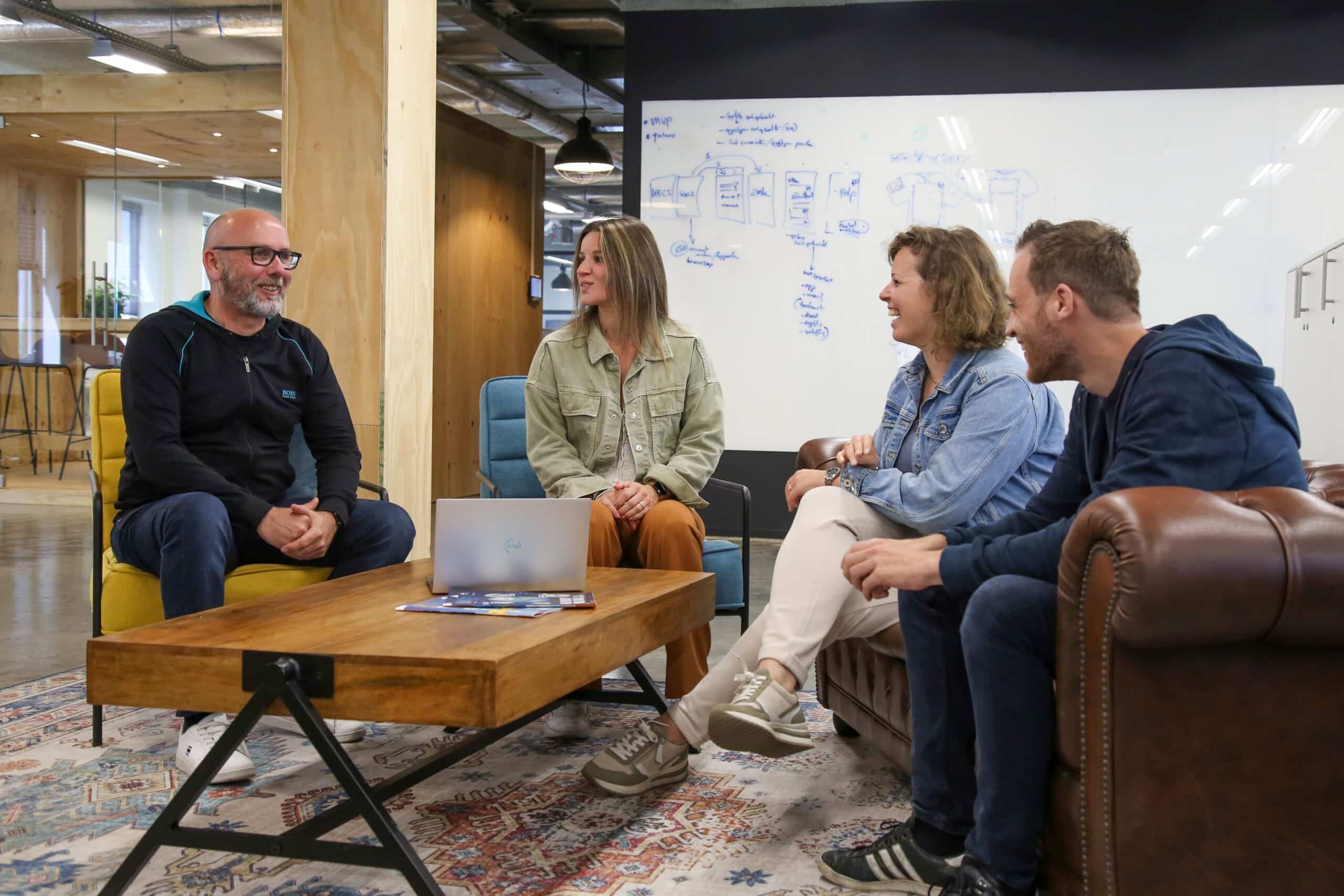How iO Upskills Its Workforce to Retain Talent
By offering its – mainly junior – employees tailored learning journeys and personal growth, iO gained several substantial benefits in return. Employees grew quicker to higher, experienced roles within the company; they felt more belonging and job satisfaction, and new talent was easier to attract from outside the company. The close collaboration between iO and Xebia Academy resulted in tailored learning solutions that fit the company’s specific learning needs. Read more to experience the full story.
Why
Meet the needs of a growing customer base
What
Move to the Azure DevOps platforms for more functionality
How
Implementing a tiered rollout of the migration journey
The war for talent
In this time of The Great Resignation, Xebia Academy and iO sat down together to come up with a plan to retain iO’s talent pool and attract new talent. One of the outcomes was that the tailored learning journey program enabled iO’s team to grow more rapidly than before. Explore how we collaborated closely with iO and learn about our journey toward setting up a successful custom learning program.
“It remains difficult to find good people in the market,” says Friso Geerlings, Technology Director at iO in Eindhoven. “Everyone is looking for communicative team players with a solid technical base.”
iO is an end-to-end agency with a growing team of experts in communication and digital transformation. With services in strategy, content creation, marketing, and technology, they work in a highly volatile digital market. One of the cornerstones of their success is the iO campus concept, a place where they can meet and exchange ideas with colleagues, clients, and partners, spread all over Europe.
Friso is in charge of the Technology service line, a team of engineers focused on creating tools to solve complex web and integration problems. Think about financial services and security-related projects, though their scope also extends to complicated e-commerce platforms that incorporate many other systems.
Currently, roughly 150 people work at the iO campus in Eindhoven, to design and run technical projects for airports, medical service providers, and financial institutions. Attracting talent remains a complex and universal problem, however. Demand is high, especially in the Eindhoven region. Unsurprisingly, iO needs more than 150 specialists to enable its growth. That’s one of the multiple reasons why iO has chosen to invest even more in its people. More specifically, in jointly creating development programs for the talent pool that is already in-house.

Friso Geerlings
Technology Director at iO
Technology Director at digital specialist iO, location Eindhoven, with a passion for open technology, integration technology, and ‘getting things done’ in tech teams. Friso has a major focus on getting the best out of a skilled tech team staffed with professionals.
“One of the strong – if not the most powerful – elements of this collaboration and training: besides the conventional building blocks, we can expand the training course with challenges we experience within IO.”
Friso is in charge of the Technology service line, a team of engineers focused on creating tools to solve complex web and integration problems. Think about financial services and security-related projects, though their scope also extends to complicated e-commerce platforms that incorporate many other systems.
Currently, roughly 150 people work at the iO campus in Eindhoven to design and run technical projects for airports, medical service providers, and financial institutions. Attracting talent remains a complex and universal problem, however. Demand is high, especially in the Eindhoven region. Unsurprisingly, iO needs more than 150 specialists to cope with its growth.
Learning and training
on the job
Through this combination of gaining experience and following tailored training, Friso believes that, as they have already experienced, these talented juniors can handle more responsibility much sooner – more than you would expect from people who have just left school.
For example, Friso and his team saw that junior software developers, with their limited experience and only two rounds of training, were already at a level that would typically require someone with ten years of experience to reach. A challenging job for any recruiter to do.
“Our ambition is, therefore, to offer our employees (even) bigger learning journeys,” Friso continues. “To delve a bit more into simple analysis methods and customer understanding. We want to include training like Xebia Academy’s as a standard part of their personal growth and development plan.”

Better than hiring: upskilling internal talent
Since 2016, iO has been working with Xebia Academy. Seven years later, they’ve already run about 30 training days together. In close collaboration, we’ve set up various learning journeys that fit the development paths that have been set up for iO’s employees.
What is particularly pleasing about this cooperation is that a training course has been jointly developed that is completely tailored to iO’s needs, Friso explains. Based on proven Xebia Academy’s building blocks, but adapted to the target group within iO.
On a daily basis, the software developers taking part in these courses deal with questions like: “How can I ensure that the software meets the customer’s needs? And when coming across an issue, is the customer aware of the issue? Is it perhaps a known unknown or an unknown unknown?”
Together with the customer, they will then explore a possible software solution. The goal is to determine what the software needs to do and test the requirements in an iterative process. However, a more efficient process and proven methodology could directly speed up this process, run projects more efficiently, and deliver faster.
So, iO and Xebia Academy sat down to determine the specific demand for the desired learning journey around customization and integration projects. In doing so, we defined two axes:
- The People ➡️ Dealing with shortage.
- The Projects ➡️ Dealing with complexity.
The result of our deliberation was that we developed training that included a combination of both Domain-Driven Design and Agile Architecture.

A custom software development learning program
“Software is beyond the point of writing requirements and building out. We went to an Agile process to see results quickly and then iterate,” Friso states.
The first group of people who went to the training comprised 15 young software developers who were excited to become an architect. This five-day training can roughly be divided into two parts:
- Three days Domain-Driven Design (DDD), and
- Two days Collaborative Agile Architecture.
The training course covers, among other elements, the topics below.
- Before diving into a project, the software developers should first take a step back and examine the big picture, learning as much as possible about the customer’s domain and the more complex requirements.
- They also need to be able to split their project into manageable chunks, which is called ‘bounded context’. What is a subdomain? What is its boundary? And what can I say about that boundary?
- Another element is, “How can you make a client envision the stakeholders needed for the software project?” Thinking thoughtfully about the architecture needed and the development of that architecture at an early stage is a crucial part of your software project. With Domain-Driven Design methodologies, you can involve the right stakeholders in time and make proper arrangements before the project kicks off.
More than three rounds of this training have been organized. After each round, iO and Xebia Academy work together to fine-tune the training content and setup.
One of the outcomes of that fine-tuning was the desire to go more in-depth. For example, the content of one of the latest courses focused more on IO-specific cases. As a result, last fall’s program was even more extensive than the previous learning sessions.
As Friso put it:
“One of the strong, if not the most powerful, elements of this collaboration and training: besides the conventional building blocks, we can expand the training course with challenges we experience within IO.”
“The mix of theory, cases, and practical exercises is beneficial to us and is all made to fit the needs of iO’s customers.”
Tailored training solutions for the best outcome
With the developed learning program, we ensure that we complement the technical skills that college and university graduates had already acquired during their studies. By mimicking a software developer’s practical skill development, they can experience the skills they usually acquire during the first few years on the job.
The learning journeys are aimed at helping employees with different experience levels, though the first classes were aimed at iO’s ‘newbies’. Often, employees who freshly started at the company and just left college or university. These journeys not only open opportunities for employees but also for iO and the different project teams within the organization.
As students gain experience as ‘software developers, iO equips them with the skills necessary to advance to the ‘architect’ role on complex software development projects.
In the words of Friso, “With the correct and, thus, greater experience in architecture and technique, as well as the direction of professionals who also like educating young people, we can assist our teams to grow and develop more quickly.”
This means that iO can quickly promote junior workers to more medior roles in projects where their colleagues are familiar with iO processes. Consequently, employees who’ve been in a medior position can move on to senior positions at a higher pace. A win for all.
The secret to learning success
The mix of theory, cases, and practical exercises is beneficial to the overall learning goals and is all tailored to fit the needs of iO’s customers.
Friso is confident that you don’t have to remember 100% of a training course you followed. He believes it’s more important to apply what you learned to your context. Know what else is out there so you can make a conscious decision.
By running some large projects themselves, the trainees could experience in real life which elements of the course they could apply themselves. At the same time, they were able to come up with new questions, which served as input for their own unique learning journey.

“With the correct and, thus, greater experience in architecture and technique, as well as the direction of professionals who also like educating young people, we can assist our teams to grow and develop more quickly.”
Every ten weeks, the learning journey trainees meet again with a trainer at Xebia Academy to discuss progress and developments. The outcomes and findings of these sessions also serve as new material to refine the training further.
This is how we safeguard that the latest technical issues always align with reality. Quite a challenge, as you can imagine, given the rapid developments in technology.
For Friso – and everyone involved at Xebia Academy – these return sessions are great fun as we can all witness the tremendous growth that a team has gone through in that period. As the participants feel this growth too, they also become aware of how their projects and client communication have improved considerably.
That’s the real treasure of the project: the goal of starting this collab in the first place. When team members realize they’ve evolved professionally or personally, the project’s overall quality improves. As a result, the whole company’s quality rises.
“Within iO, we have partnered with Xebia Academy to put money into the company’s most valuable asset: its people,” Friso concludes. “We contribute to the future and present success of iO and our clients by investing in our internal talent.”
iO’s learning program results
In short, the success of iO’s learning program can be summarized as follows.
- iO’s junior software developers can advance to the architect role on complex software development projects. In fact, junior software developers were already at a level that would typically require someone with ten years of experience to reach.
- Junior software developers can handle more responsibility much sooner, so they move to medior roles quicker than before.
- iO employees in medior positions can move on to senior positions at a higher pace, resulting in faster growth and development for the teams involved.
- Higher retention and job satisfaction among the trained employees.
- A proven case to develop similar learning programs for different roles, like data roles.
Are you looking to upskill your team(s) or employees? Let us know; we are happy to help you with a tailor-made learning solution or setting up an entire Tech Academy.
Skills applied
01
Domain-Driven Design
02
Collaborative Agile Architecture
03
Software Development
Collaborative Agile Architecture: Facilitating Software Design Decisions
Domain-Driven Design (DDD) Foundation
Looking for custom solutions for your team(s) or organization?
We’ll gladly help you explore all our enterprise options tailored to your needs.
Do you have any questions?
Contact us for any questions about the training, administration, directions, or whatever is on your mind. We’re happy to help!